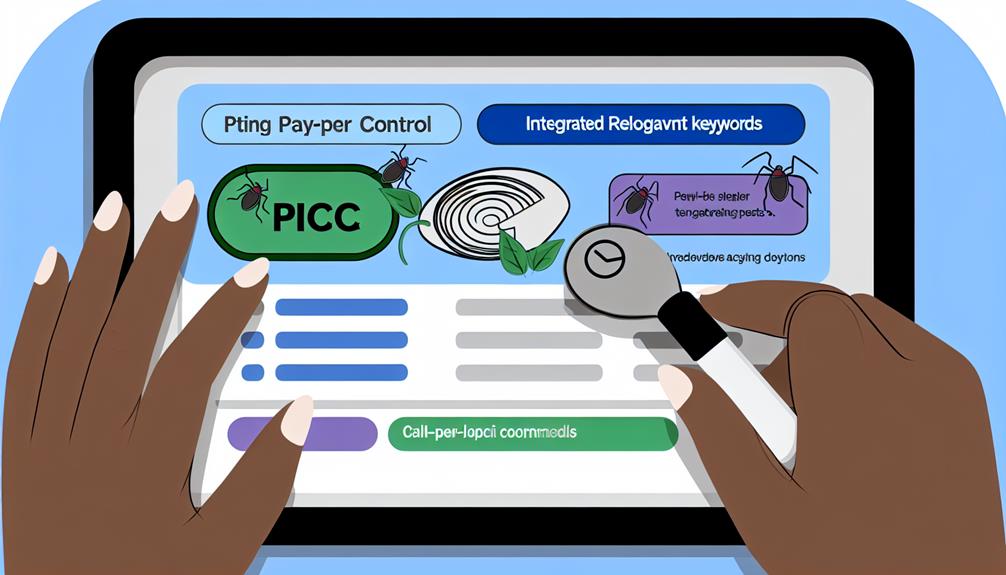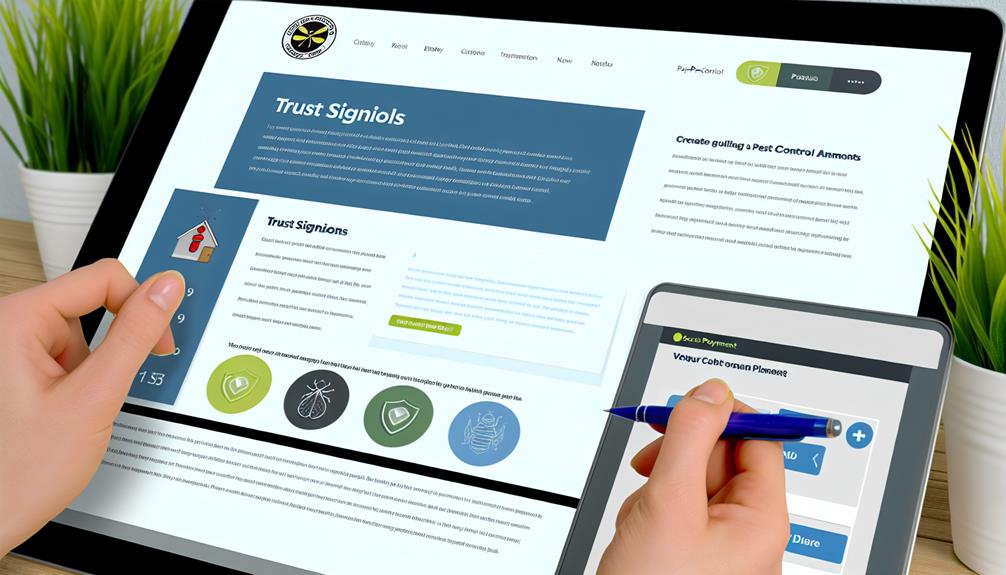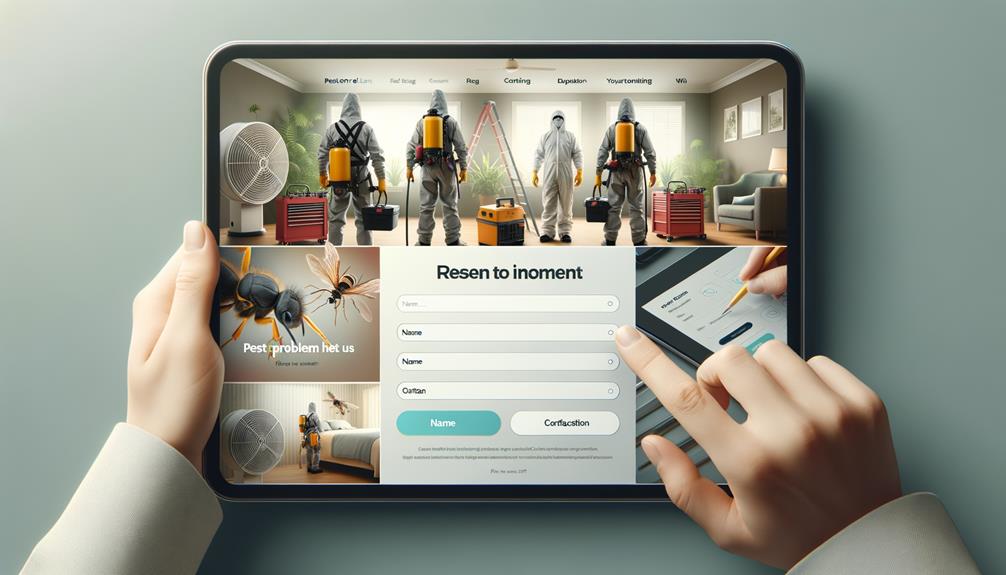When it comes to pest control PPC landing pages, think of them as the inviting front door to your virtual storefront. Just as a well-maintained entrance can entice customers to step inside, a well-crafted landing page can draw potential clients deeper into your services.
You might be surprised to learn that there are nine key practices that can make your pest control PPC landing pages more effective and impactful. These practices can significantly improve your online presence and help you attract more qualified leads.
Table of Contents
ToggleKey Takeaways
- Categorize user intent into informational, navigational, and transactional to better understand their needs and create targeted landing pages.
- Craft compelling ad copy that uses emotional appeal, highlights brand differentiation, provides a clear call-to-action, and promotes compelling offers to encourage immediate action.
- Implement relevant keywords by conducting thorough keyword research and using tools like Google Keyword Planner or SEMrush to improve quality scores and capture the attention of potential customers.
- Design effective call-to-actions by utilizing actionable button text, clear and concise language, a sense of urgency, and clearly stating the benefit or value. Additionally, optimize landing page design by placing the call-to-action prominently, choosing a contrasting button color, optimizing for different browsing behaviors and devices, and ensuring easy accessibility and usability on mobile screens.
Understanding User Intent

Understanding user intent is crucial for creating effective pest control PPC landing pages that engage and convert potential customers. By understanding user behavior and search intent, you can tailor your landing page content to directly address the needs and desires of your target audience.
User intent can be categorized into informational, navigational, and transactional, and your landing page should align with these different intents to provide a seamless user experience.
To understand user behavior, analyze the keywords and phrases they use when searching for pest control services. Are they looking for information about different pest treatments? Are they trying to find a specific pest control company? Or are they ready to schedule a service? By understanding these nuances, you can create targeted landing pages that address each specific user intent, increasing the likelihood of conversion.
Additionally, consider the user’s stage in the buying cycle. Someone in the awareness stage may be looking for educational content, while someone in the decision stage may be comparing different pest control providers. By aligning your landing page content with the user’s intent and stage in the buying cycle, you can effectively guide them towards taking the desired action, whether it’s signing up for a newsletter, requesting a quote, or scheduling a service.
Crafting Compelling Ad Copy
To create effective pest control PPC landing pages, it’s essential to craft ad copy that captivates and persuades potential customers to take action. Crafting compelling ad copy involves strategically incorporating emotional appeal and brand differentiation to set your pest control services apart from the competition. Here are five essential elements to consider when crafting persuasive ad copy:
- Emotional Appeal: Connect with your audience by addressing their fears and concerns about pests invading their homes. Use language that evokes emotions such as relief, safety, and comfort.
- Brand Differentiation: Highlight what sets your pest control services apart from others. Whether it’s your eco-friendly approach, cutting-edge technology, or exceptional customer service, emphasize the unique value you offer.
- Clear Call-to-Action: Clearly instruct potential customers on the action you want them to take, whether it’s scheduling a service, requesting a quote, or signing up for a newsletter.
- Compelling Offers: Use persuasive language to promote special offers, discounts, or guarantees that encourage immediate action.
- Trust Indicators: Incorporate trust-building elements such as customer testimonials, industry certifications, and years of experience to instill confidence in your services.
Crafting ad copy that resonates emotionally and highlights your brand’s unique strengths can significantly impact the success of your pest control PPC landing pages.
Implementing Relevant Keywords

When implementing relevant keywords for your pest control PPC landing pages, focus on selecting terms that closely align with the intent of potential customers searching for pest control services.
Start by conducting thorough keyword research to identify the most relevant and high-performing keywords for your ads. Consider using tools like Google Keyword Planner or SEMrush to find keywords that are specific to the pest control industry and have a high search volume.
Look for terms that reflect different aspects of pest control services such as ‘exterminator near me,’ ‘pest control services,’ or ‘rodent removal.’
Once you have identified the most relevant keywords, ensure that your ad copy aligns with these keywords to maximize ad relevance. Create ad headlines and descriptions that incorporate the chosen keywords in a natural and compelling manner.
This won’t only improve the quality score of your ads but also increase the likelihood of capturing the attention of potential customers who are actively seeking pest control services.
Creating Clear Call-to-Actions
When crafting your pest control PPC landing pages, it’s crucial to focus on creating clear call-to-actions to drive conversions.
Utilize actionable button text that clearly communicates the desired action, and strategically place CTAs to maximize visibility and engagement.
Actionable Button Text
Craft compelling button text that prompts visitors to take action and engages them with your pest control PPC landing pages. When creating actionable button text for your pest control PPC landing pages, keep in mind the following best practices:
- Clarity: Use clear, concise language that clearly communicates the action you want the visitor to take.
- Urgency: Create a sense of urgency to encourage immediate action, such as ‘Book Now’ or ‘Get Your Free Quote Today.’
- Value Proposition: Clearly state the benefit or value the visitor will receive by clicking the button, such as ‘Save 20% Today’ or ‘Protect Your Home.’
- Contrast: Ensure the button stands out visually on the page to draw attention and encourage clicks.
- A/B Testing: Continuously test different button text to optimize for the highest conversion rates.
Strategic Placement of CTA
To maximize the effectiveness of your pest control PPC landing pages, strategically place your call-to-action (CTA) in prominent and easily accessible locations to prompt visitors to take action.
The button color plays a crucial role in drawing attention to your CTA. Choose a color that contrasts with the rest of the page layout, making it stand out.
Additionally, ensure that the CTA is placed above the fold, where visitors can easily see it without having to scroll down.
Consider placing it in multiple locations on the page, such as at the top and bottom, to cater to different browsing behaviors.
Designing Mobile-Friendly Pages

Achieve optimal user experience by ensuring that your pest control PPC landing pages are designed to be fully functional and visually appealing on mobile devices. Mobile optimization is crucial for reaching your target audience effectively.
Here are some key considerations for designing mobile-friendly pages:
- Responsive Design: Implement a responsive design that adapts seamlessly to various screen sizes, ensuring a consistent user experience across all devices.
- Fast Loading Speed: Optimize your page to load quickly on mobile devices, as slow loading times can lead to high bounce rates and decreased conversions.
- Clear Call-to-Action (CTA): Make sure that your CTA buttons and forms are easily accessible and usable on mobile screens, encouraging visitors to take action.
- Streamlined Content: Condense and prioritize content for mobile users, presenting essential information in a concise and easy-to-digest format.
- Mobile-Friendly Navigation: Simplify navigation by using mobile-friendly menus and clear pathways to help users find the information they need efficiently.
Utilizing Localized Messaging
To effectively connect with your local audience, it’s crucial to utilize localized messaging on your pest control PPC landing pages.
Tailoring your language and incorporating regional references can make your messaging more relatable and impactful for potential customers in specific geographic areas.
Localized Language
By tailoring your messaging to resonate with the specific needs and preferences of your local audience, you can significantly enhance the effectiveness of your pest control PPC landing pages.
When incorporating localized language, consider using local slang and cultural references to connect with your audience on a personal level. Here are some effective strategies to implement localized language:
- Use colloquial terms that are commonly used in the local area.
- Incorporate cultural references that are relevant to the local community.
- Understand the local dialect and language nuances.
- Highlight local events or landmarks that are recognizable to the community.
- Personalize your messaging to align with the unique traits of the local audience.
Regional References
Incorporating regional references into your localized messaging can establish a strong connection with your audience, fostering a sense of familiarity and trust in your pest control PPC landing pages.
Cultural sensitivity is crucial when using regional references to ensure that the messaging resonates positively with the targeted audience.
By integrating geographic targeting, such as mentioning specific local pests or common pest control concerns in the region, you can demonstrate a deep understanding of your audience’s needs. This personalized approach not only improves user experience but also enhances the credibility of your pest control services.
When potential customers see that you’re aware of the unique pest challenges in their area, it builds trust and increases the likelihood of them engaging with your business.
Incorporating Trust Signals

Boost your pest control PPC landing page credibility by incorporating trust signals that reassure potential customers of your expertise and reliability. Here’s how to do it:
- Customer Testimonials: Feature authentic testimonials from satisfied customers to showcase positive experiences and build trust.
- Social Proof: Display social media engagement, such as likes, shares, and comments, to demonstrate a strong and engaged community.
- Trust Badges: Incorporate trust badges from reputable organizations, such as BBB accreditation or industry-specific certifications, to convey credibility and reliability.
- Authority Endorsements: Showcase endorsements or partnerships with industry authorities, organizations, or influential figures to bolster your reputation.
- Industry Certifications: Highlight relevant industry certifications or affiliations to establish your expertise and adherence to industry standards.
Testing and Iterating Continuously
To continuously improve your pest control PPC landing pages, it’s essential to implement a rigorous testing and iteration process to optimize performance and conversion rates.
Continuous improvement is crucial in the competitive landscape of digital marketing. User experience testing should be an integral part of your strategy to ensure that your landing pages are effectively engaging and converting visitors.
Through A/B testing, you can compare different versions of your landing page to identify which elements resonate best with your audience. This iterative process allows you to make data-driven decisions to enhance the overall user experience and maximize conversions.
Optimizing for Conversion Tracking
For effective pest control PPC landing pages, ensure that your conversion tracking is optimized to accurately measure and attribute user actions, ultimately providing valuable insights for refining your campaign strategies. Optimizing for conversion tracking is crucial for maximizing the effectiveness of your pest control PPC landing pages.
Here are some best practices to ensure your conversion tracking is optimized:
- Implement tracking codes: Utilize tracking codes provided by your PPC platform to accurately track conversions on your landing pages.
- Set up goals: Define specific conversion goals such as form submissions, phone calls, or downloads to track and measure the success of your landing page.
- Utilize event tracking: Implement event tracking to monitor specific user interactions on your landing page, such as clicks on call-to-action buttons or video plays.
- Test and refine: Continuously test and refine your conversion tracking setup to ensure accuracy and relevance of the data collected.
- Integrate with analytics: Integrate your conversion tracking with analytics tools to gain a comprehensive understanding of user behavior and optimize your pest control PPC campaign accordingly.





